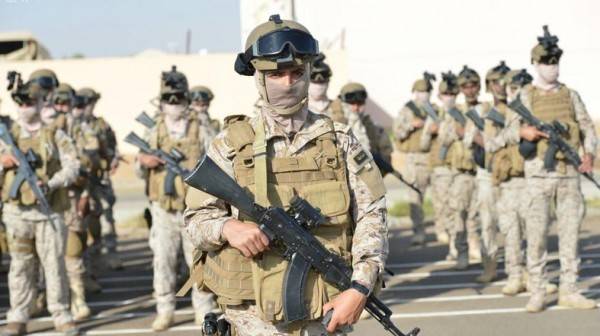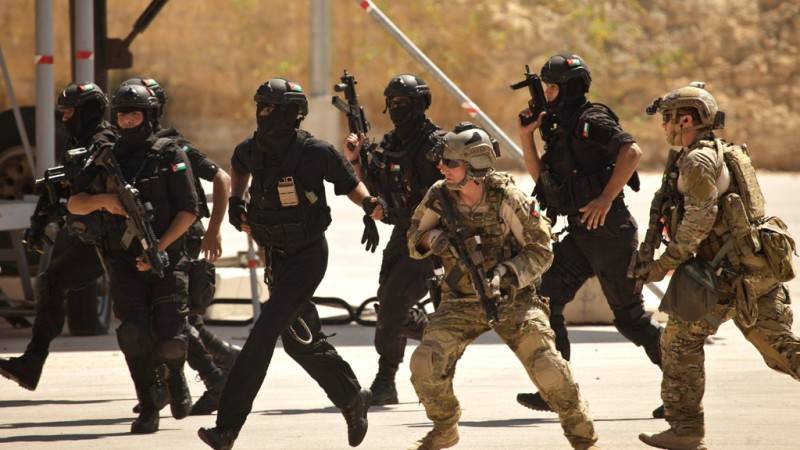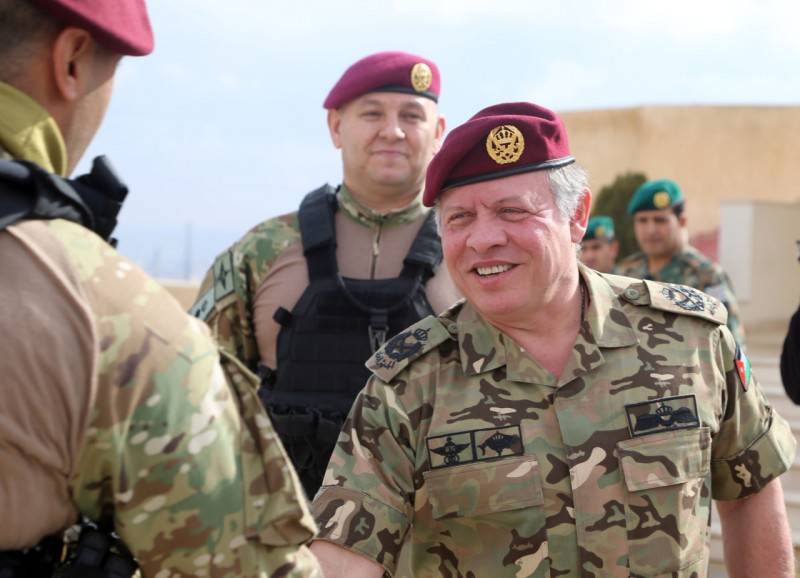State of the Special Operations Forces of the Middle East

MTR servicemen of NATO and other Western countries play an important role in training and supporting their counterparts in the Blednevostochny region in the fight against the rebels.
Special operations forces in the Middle East are at the forefront of counter-terrorism and counter-insurgency efforts throughout the region, but their ability to conduct special operations remains limited.
Communication with sources at the headquarters of NATO’s special operations in Mons, Belgium, demonstrates that the special forces of the Middle East benefit from the material assistance and training provided by Western countries in the fight against various factions, including ISIL.
The various components of the MTR from NATO and other Western countries (including the special operations commanders of Australia, Canada, Novregii, the United Kingdom and the United States - continue to “train, advise and assist” local law enforcement and special forces in Iraq and Syria.
The recipients of such assistance are the Free Syrian Army, the Iraqi Special Operations Forces and the special forces of the Kurdish Peshmerga.
This concept of cooperation remains typical for the MTRs of the Middle East countries who met on May 9 2016 at the Conference of the Commanders of Special Operations Forces of the Armed Forces of the Near and Middle East (MESOC) in Jordan.
The conference, which was attended by partners from Australia, France, Poland and the United States in addition to representatives from countries of the region, expressed the idea that an important part of the development of special forces in the future would be both new technologies and the ability to conduct operations at the international and interdepartmental levels.
Speaking at the conference, Colonel Andre Harivon noted that the priority today is to preserve technological superiority, especially with regard to intelligence, observation, as well as mortality and mobility.
FAST PACED
Jordan’s MTR command continues to evolve at high rates and is expanding to meet counter-terrorism and counter-insurgency tasks.
Designated as a rapid reaction force, the command includes the 37 Special King Abdullah II Brigade, which leads the 71 Special Operations Squad, the 81 Special Parachute Battalion and the 101 Special Forces Group, and the 28 Ranger Brigade behalf of Prince Hussein Bin Abdullah II.
However, on May 10, 2016, it was announced that the command would expand even further with the goal of establishing the Quick Reaction Force, which would resemble US Army ranger battalions in projection capabilities.
The commander of the Special Operations Special Command, Brigadier General Adnan Ahmad Al-Abbadi, says that such an innovation is the need to reduce the burden and responsibility of other units subordinate to the command.
Rapid Response Forces, according to sources in Jordan’s OKSO, will be able to respond immediately to threats using ground-based equipment and aviation from the availability of the Special Operations Aviation Brigade.
At the same time, OXO is going to expand its capabilities in the framework of search and rescue operations by creating a special unit for these purposes. According to sources from the command, it will include various elements of the Special Forces Brigade and the aforementioned Aviation Brigade.
This step is a response to the capture and execution of pilots of the Jordanian Air Force by the igilovs in December 2014.
OXO Jordan continues to cooperate with Western allies in matters of training and combat use. In March, the 2016 disclosure of secret documents revealed that OXO units worked together with the British MTR in Somalia. The purpose of the operations was to counteract the Al-Shabab grouping together with the Somali law enforcement agencies.

Moreover, OXO is currently working with NATO partners to increase the combat capability of the forces fighting in Syria against ISIS. Since May 2016, the Norwegian special operations task force has been working in Jordan, consisting of 60 members of the Forsvarets Spesialkommando (FSK) and Marinejegerkommandoen division (MJK ).
Finally, the Jordanian OXO continues to cooperate with the Operational Detachment Alpha Special Purpose Group in the area of King Faisal Air Base in Al-Jafra, where personnel train and provide support to the factions in Syria.
STRATEGIC ALLY
The United Arab Emirates Special Operations Forces Command (United Arab Emirates) plays the role of a strategic ally of NATO and the forces of the Middle East coalition. Former US Secretary of Defense Ashton Carter in February 2016 of the year called the country a "key" partner.
It is believed that the units of the OAE KSSO are deployed in Syria as part of a broader training program for local forces to assault Rakka.
The command also pays great attention to the development of such competencies as the anti-terrorist struggle and the release of hostages. All of this was demonstrated during an operation to rescue British subjects from the hands of al-Qaida in the Arabian Peninsula in Yemen.
This operation demonstrated the growing capabilities of the MTRs of the Middle East countries independently and without the help of coalition partners to solve problems of high complexity.
The UAE’s KSSO continues to work on the improvement of technologies and equipment to improve the combat capability of its units — in particular, the 18-I Group 18 Special Forces Aviation Unit. Now on its armament are helicopters SA 330 Puma, CH-47F Chinook, UH-60M Black Hawk and AS550 Fennec. The command intends to expand the fleet with a Boeing CV-22 converters.
Representatives of Boeing and Command did not comment on a promising deal.
As for ground-based equipment, in December 2016 was announced after passing tests in the harsh desert conditions in 2015-2016. Armored car Ajban produced by the Emirates company Nimr Automotive was adopted.
According to sources, competitors in the tender were cars Flyer 72 (General Dynamics Ordnance and Tactical Systems), as well as MRZR-4 and DAGOR (Polaris Defense).
Cars will be involved in intelligence operations, as well as for other tasks.
OPERATIONS IN YEMEN
Also actively involved in solving anti-terrorism and counterinsurgency tasks involved the command of Saudi Arabia’s Army Special Operations Command, which conducted combat operations against the Hussites in Yemen. KSOSV also works on the border with Kuwait and Iraq.
According to Brigadier General Ahmen Asiri, the scale of operations in Yemen began to decline in March 2016, and now attention is being paid to helping to restore the infrastructure, as well as training and assisting government forces.
Also, representatives of Saudi special forces announced the priority for them to support the coalition against LIH in Syria. Asiri noted that "the Kingdom is ready to participate in any ground operations in Syria that the coalition will be ready for."
This signals a growing contribution of the country to current operations in addition to the air operation, which began in September 2014 of the year.
Such statements were again voiced by Saudi Arabian Foreign Minister Adel Al Jubeir, who during a press conference announced ongoing negotiations on the involvement of Saudi Arabian MTR in operations in Syria within the framework of the US-led coalition.
“The Kingdom of Saudi Arabia expresses its readiness to provide special forces if necessary,” he explained.
Saudi Arabian MTRs also conduct joint exercises with Middle Eastern partners, including Northern Thunder, held in March, with the participation of 20 countries. As part of the exercise, the Kuwait and Iraq MTRs worked closely together with an emphasis on the anti-terrorism and counterinsurgency actions of small units.
FIGHTING ACTION
At this time, Iraq’s counter-terrorism forces are constantly engaged in hostilities against ISIS. Together with NATO and the Kurds, there is a joint work on the capture of Mosul.
The offensive was preceded by Iraqi MTR operations aimed at the return of Ramadi, Heath, Rutbah and Fallujah, along with American and Australian MTRs. The individual parts of the Special Air Service Regiment and the 2 Regiment of Commandos operate within the framework of the special operations task force and are engaged in training and assisting Iraq’s MTR operations against ISIL.
During a roundtable with media representatives 18 October 2016, Australian officials announced that in the future the operation will focus on direct aviation support to Iraqi MTR units.
Iraq’s special operations forces receive new equipment, including an undeclared number of M-ATV armored cars produced by Oshkosh Defense, which are now involved in urban battles on the outskirts of Mosul. Iraqi SSOs use these cars to capture and hold open areas of rural areas in northern Iraq to launch a ground attack on a city.
M-ATVs are also used by Iraqi MTR assault detachments, with the support of regular troops and foreign partners, house-to-house, freeing the city from the enemy.
EXPEDITIONARY FORCE
On the Iranian border, an 65 special purpose brigade is becoming increasingly involved in the conflict - due to the law of April 2016, allowing it to be used abroad.
In the area of engagement of personnel include Iraq and Syria. In the latter, the activity of the Codus division, which is engaged in the formation of the Shiite liberation army to support the troops of Bashar al-Assad, is noticeable.
It is believed that Iranian operatives are actively working in the Aleppo area and are conducting military operations with the support of the UAV. This is confirmed by the statements of the Deputy Chief Communications Officer of the Iranian Ground Forces, General Ali Arasteh, who in April 2016 mentioned the group of military advisers.
It is believed that the unmanned aerial vehicles used include Iranian-made Yasir, whose flight duration is up to eight hours at altitudes up to 5 kilometers. The combat load is up to 40 kg, the range is up to 150 kilometers.
At the same time, the Iranian military is also working hard on its territory - in the province of Khuzestan in the south-west of the country and also in the north, on the border with Azerbaijan.
With regard to training, the Iranian SSO actively cooperate with Russian special forces on the issues of tactics and the use of small groups in anti-terrorist and counterinsurgency operations. Sources from military circles said that the last such teaching took place in August 2016.
GO FORWARD
Despite the rapidly changing environment, which does not leave the force of the special operations of the countries of the region without work, the main driving force for the development of local MTRs is cooperation with other countries - be it NATO, Russia or China.
The cooperation lies not only in the field of training, but also, and most importantly, in the framework of joint operations, which today take place with varying success.
During the NATO countries ’operation in Afghanistan, the coalition countries’ MTRs regularly conducted joint operations with local law enforcement agencies, but the Afghan military often refused to lead such operations. The same story and with the Middle East region, whose countries show varying degrees of maturity in the conduct of operations.

Information